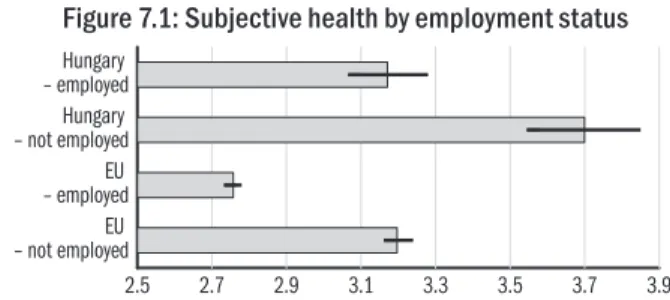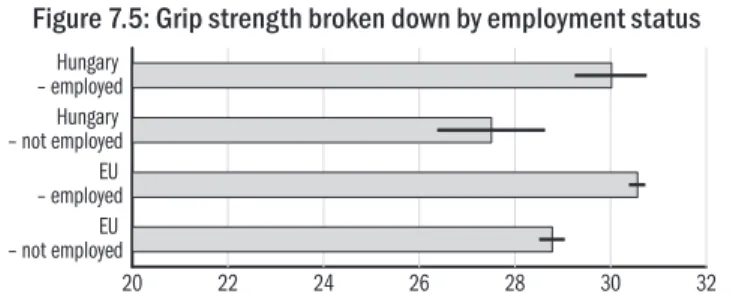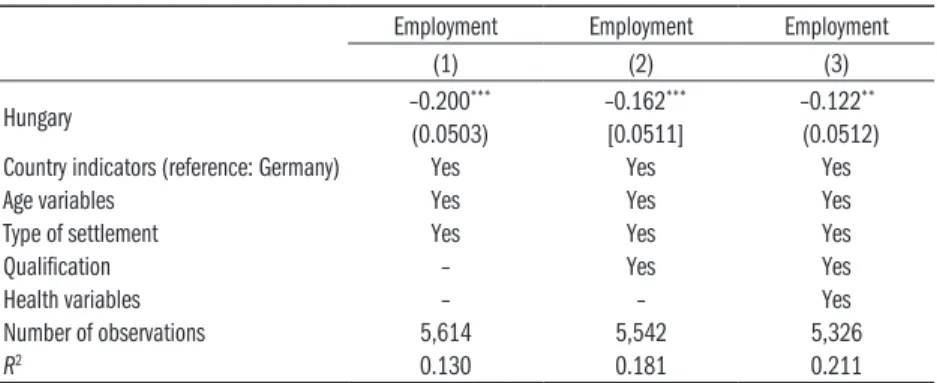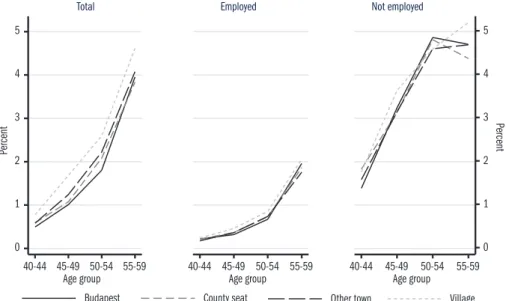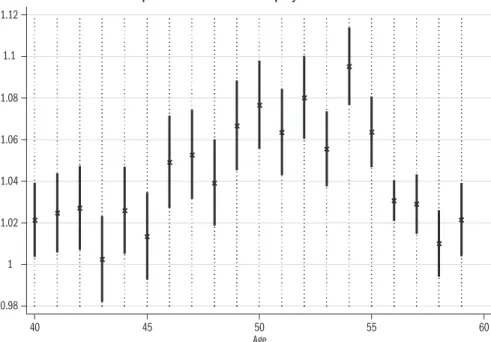7 HUMAN CAPITAL, PART IV
HEALTH AND LABOUR MARKET PARTICIPATION AMONG WOMEN
Anikó Bíró, Réka Branyiczki & Péter Elek
Ability to work is affected by mental and physical health, which may contrib- ute to the fact that Hungarian women, especially those over 50, fall behind the EU average in labour market participation. At the same time, labour mar- ket participation also has an impact on health.
Based on international literature, we know that unemployment has a nega- tive impact on mental health (Thomas et al. 2005, Schaller–Stevens, 2015);
however, there is no consensus regarding its impact on physical health. As for the health effects of retirement, research results are not consistent either (for example van der Heide et al. 2013, Insler, 2014, Behncke, 2012). On the other hand, bad health has been found to have a negative impact on employability (García-Gómez et al. 2013, Riphahn, 1999) and it reduces the probability of re-employment after unemployment (Stewart, 2001).
Due to a lack of individual-level panel data on health, there is little knowl- edge of the causal link between health and labour market participation in Hungary. Based on administrative and questionnaire-based data, this subchap- ter provides an overview of the relationships between the health and labour market participation of women and points out divergence from European patterns and possible causalities.
Health and labour market participation among women aged 50+
in European comparison, based on SHARE data Descriptive analysis
The SHARE (Survey of Health, Ageing and Retirement in Europe) data- base1 provides detailed data on the health and labour market participation of women over 50. It is an internationally harmonised, multidisciplinary panel survey, which collects data biannually about the health, labour market situa- tion and socio-economic characteristics of the population over 50, allowing the comparison of the health of working and non-working women. The data are available to the entire research community free of charge.
Hungary joined the survey in its fourth wave, in 2011,2 with a sample of about 2000 households including 1700 women, nearly half of whom were working age according to the retirement age effective in 2011 (aged 50–62). Since 93 per cent of women aged over 60 are in retirement, we focused on a younger middle- aged age group: we compared the health of women aged 50–59 based on their employment status. Employed people were defined as those who reported to
1 We are using data from the 4th wave of share SHAR E (D OI : 10 . 6103/S H A R E . w4.611), for details on meth- odology see Börsch-Supan et al (2013). The SHAR E data collection was primar- ily funded by the European Commission through FP5 (QLK6-CT-2001-00360), F P 6 (S H A R E - I 3 : R I I - C T-2 0 0 6 - 0 62193 , COM- PARE: CIT5-CT-2005-028857, S H A R E L I F E : C I T 4 - CT-2006-028812) and FP7 (SHARE-PREP: N° 211909, SHARE-LEAP: N° 227822, SHARE M4: N° 261982). Ad- ditional funding was provided by the German Ministry for Education and Research, Max Planck Society for the Ad- vancement of Science, U.S.
National Institute on Ag- ing (U01_ AG09740-13S2 , P01_ AG 005842, P01_ AG- 08291, P30_AG12815, R21_
AG025169, Y1-AG-4553-01, IAG_BSR06-11, OGHA_04- 064, HHSN271201300071C) (see share-project.org).
2 The 4th wave of SHARE in- cludes the following countries:
Austria, Belgium, the Czech Republic, Denmark, Estonia, France, Holland, Poland, Hun- gary, Germany, Italy, Portugal, Spain, Switzerland, Sweden, Slovenia. The next data collec- tion was conducted in 2017 in Hungary, the data from which were published in spring 2019.
2.5 2.7 2.9 3.1 3.3 3.5 3.7 3.9 – not employedEU
– employedEU Hungary – not employed Hungary – employed
work (as an employee or self-employed), while the category ‘not employed’ in- cluded old-age pensioners, the unemployed and homemakers. The long-term sick and the disabled were not included in this part of the analysis although it is telling that their share among women aged 50–59 is 16 per cent in Hungary, more than double of the European average. Thus the sample included about 280
‘employed’ and 170 ‘not employed’. We note that the second half of this paper will focus on the health indicators of disability pensioners.
The SHARE database contains several health-related indicators: the self-re- ported general health of respondents, the number of chronic diseases or symp- toms, the number of health problems affecting ‘activities of daily living’(ADL), occurrence of various diseases, body mass index (BMI, which relates weight to height) and depression based on the Euro-D scale.3 Results from a grip test are also available, which measures grip strength, and is strongly related to the general physical condition of the elderly.
Figures 7.1–7.6 present the average value of the above indicators among working age women in Hungary compared to the other countries of the sam- ple, broken down by employment status. On average, those who work are healthier among both European and Hungarian women. It is striking that the health of Hungarian women, particularly that of the ‘not employed’ group, is generally worse than the European average.
Figure 7.1: Subjective health by employment status
Note: Average self-reported subjective health ranging from 1 (excellent) to 5 (poor) among women aged 50–59. 95 percent confidence interval of the mean is presented.
Source: Authors’ compilation based on data from SHARE.
Overall, the self-reported health of working Hungarian women is good, while that of women not working is only between good and fair, and the European averages are by half a category better in both groups (Figure 7.1). Those not working suffer from more than two chronic diseases on average and the num- ber of their symptoms exceeds two and a half. Working women report nearly one disease and one symptom less in Hungary (Figure 7.2). Women not work- ing lag behind the EU average more seriously in both indicators. The average number of health problems affecting ADL was negligible in all groups assessed.
In Hungary, half of the women not working and more than one-third of working women had high blood pressure (the corresponding European aver-
3 The Euro-D measures the symptoms of depression us- ing a 12-point scale (Prince et
20 22 24 26 28 30 32 – not employedEU
– employedEU Hungary – not employed Hungary – employed 0
1 2 3 4
EU – not employed Hungary
– not employed EU
– employed Hungary
– employed
0 1 2 3
Chronic diseases Symptoms ADL 4
High blood pressure Heart attack Diabetes Gastric ulcer Chronic pulmonary disease Cancer
0.0 0.2 0.4 0.6
EU – not employed Hungary
– not employed EU – employed Hungary
– employed
0.0 0.2 0.4 0.6
between the two groups was not statistically significant. There is a consider- able difference between the working and not working groups in the prevalence of heart attack, diabetes and chronic lung disease (Figure 7.3).
Figure 7.2: Number of chronic diseases and symptoms by employment status
Note: The average number of chronic diseases, health symptoms (for example back pain, heart problems, choking, persistent cough etc.) and health problems affect- ing ADL among women aged 50–59. 95 percent confidence interval of the mean is presented.
Source: Authors’ compilation based on data from SHARE.
Figure 7.3: Occurrence of diseases by employment status
Note: The average rate of occurrence of diseases among women aged 50–59. 95 per- cent confidence interval of the mean is presented.
Source: Authors’ compilation based on data from SHARE.
Even though the age group 50–59 was found overweight on average in both Hungary and Europe (BMI average over 25), the probability of being over- weight is higher in the non-working population (Figure 7.4). The grip test re- vealed that the grip strength of those not working is also weaker (Figure 7.5).
Figure 7.4: BMI broken down by employment status
Note: Average BMI among women aged 50–59. 95 percent confidence interval of the mean is presented.
Source: Authors’ compilation based on data from SHARE.
20 22 24 26 28 30 32 – not employedEU
– employedEU Hungary – not employed Hungary – employed
1 2 3 4 5
– not employedEU – employedEU Hungary – not employed Hungary – employed
Figure 7.5: Grip strength broken down by employment status
Note: Average grip strength (kilogramme) among women aged 50–59. 95 percent confidence interval of the mean is presented.
Source: Authors’ compilation based on data from SHARE.
Working women have better mental health (Figure 7.6). The Hungarian and European averages substantially differ in the non-working group. The average Hungarian figure for non-working women exceeds four, which is classified as clinically significant depression.
Figure 7.6: Depression broken down by employment status
Note: The average degree of depression on the Euro-D scale among women aged 50–59. 95 percent confidence interval of the mean is presented.
Source: Authors’ compilation based on data from SHARE.
Controlling for factors affecting health and labour market participation We showed that working women are healthier both mentally and physically
than those not working. This may have several reasons: working may be as- sociated with a more active and healthier lifestyle but it is also possible that women not working have left or were cut off from the labour market because of their worse mental and physical health. Although it is impossible to establish causal links in cross-sectional SHARE data, it is worth examining whether working women are also healthier if individuals of the same age, qualification, marital status and type of settlement of residence are compared in Hungary.
Table 7.1 presents the results of three linear regressions, with subjective health (1: excellent, 5: poor), the number of chronic diseases and grip strength (kilo- gramme) as dependent variables. All the three indicators show that working wom- en are healthier, even after controlling for the above demographic characteristics.
Also relying on the SHARE database, Divényi–Kézdi (2013) found that the employability of individuals with the best health and cognitive skills, aged
ability of those with worse health and cognitive skills is increasingly lagging behind the European average. It was also revealed that the difference between the Hungarian and German employment rates decreases if cognitive skills and the distribution of health in addition to demographic factors are controlled for. When partly reproducing these linear models (where the dependent vari- able is employment status again), it is seen that the 20 percentage points lag of Hungarian women aged 50–59 compared to German women would de- crease to 12 percentage points if both the demographic composition and the health of the population would correspond to the German average (Table 7.2).
Table 7.1: Average differences in health indicators by employment status, controlling for demographic and socio-economic factors,
among women aged 50–59 in Hungary Subjective health (1) Number of
chronicdiseases (2) Grip strength (3)
Working –0.364*** –0.707*** 1.908**
(0.123) (0.208) (0.932)
Control variables Yes Yes Yes
Number of observations 334 334 326
R2 0.167 0.188 0.095
Note: Robust standard errors in brackets.
Control variables: age variables (age and age squared), qualification (5 ISCED catego- ries), marital status (married or cohabiting, single, widow), type of settlement (five categories from urban to rural).
*** p < 0.01, ** p < 0.05, * p < 0.1.
Source: Authors’ calculation based on data from SHARE.
Table 7.2: Differences in employment rates between countries, controlling for age, qualification, type of settlement and the distribution of health,
among women aged 50–59
Employment Employment Employment
(1) (2) (3)
Hungary –0.200*** –0.162*** –0.122**
(0.0503) [0.0511] (0.0512)
Country indicators (reference: Germany) Yes Yes Yes
Age variables Yes Yes Yes
Type of settlement Yes Yes Yes
Qualification – Yes Yes
Health variables – – Yes
Number of observations 5,614 5,542 5,326
R2 0.130 0.181 0.211
Note: Robust standard errors in brackets.
Control variables: age variables (age and age squared), qualification (based on ISCED), type of settlement (five categories from urban to rural), health (number of chronic diseases, grip strength, subjective health).
*** p < 0,01, ** p < 0,05, * p < 0,1.
Source: Authors’ compilation based on data from SHARE.
0 200 400 600
Thuosand HUF
40 45 50 55 60 65
Total expenditure
0 20 40 60
Percentage
40 45 50 55 60 65
Hospitalization
0 2 4 6 8 10
Percentage
40 45 50 55 60 65
age 5-year mortality
0 50 100
Percentage
40 45 50 55 60 65
age
age age
Share in the population
Employee Disability pensioner Old-age pensioner Other
The associations between labour market status, health expenditure and mortality
Health expenditure and mortality by labour market status
The individual-level administrative panel database of the Databank of the Institute of Economics of the Centre of Economic and Regional Studies of the Hungarian Academy of Sciences (IE CERS HAS), which covers a ran- domly selected 50 per cent of the population in the period 2003–2011, does not contain direct information on disease but includes data on healthcare use, mortality and labour market information. From these data an associa- tion between health and labour market status may be inferred, and hence the findings from the SHARE data can be supplemented.
Figure 7.7 presents the average health expenditure for 2011 (the sum of outpatient, inpatient and prescribed pharmaceutical expenditures), the prob- ability of hospital stay, and the probability of death calculated from 2006 on- wards by age, for the categories of working women, those receiving disability or old-age pension and for women not belonging to any of the above three categories. The bottom right panel of the Figure contains the share of the various employment categories by age within the entire population in 2011.4 Figure 7.7: Annual per capita health expenditure, probability of hospital stay, five-year probability
of death and the share in the total population by employment category, women aged 40–64
Note: Data are from 2011, except for the five-year probability of death, which is from 2006.
Source: Authors’ calculation based on the administrative database of IE, CERS, HAS. 4 Expenditure data are annual,
therefore the analysis takes years as timescale. Women are considered working if they worked at least for six months in a given year. A person on old-age pension or disability pension is defined as someone who is not in employment and received the benefit for at least six months in the given year.
Figure 7.7. only includes data on categories whose share in the given age group reached a minimum threshold in 2011.
The Figure reveals that 4–8 times more healthcare expenditure is allocated to disability pensioners than to working women in the 45–54 age group. The Figure does not show but the difference within the category is similar (4–10- fold) for inpatient care and prescription medicines but it is only threefold for outpatient expenditure. The annual probability of hospital stay in this age group is 10–12 per cent for working women, while it is 41–46 per cent for women on a disability pension. All this points to the dramatically worse health of women on a disability pension, confirmed by the bottom left pan- el of Figure 7.7. showing the five-year probability of death by age and em- ployment category. Women on a disability pension have a 7 per cent, while working women a much less than 1 per cent risk of death within five years in the 45–54 age group.
The figures indicate a smaller difference in the health indicators of women on old age pension and those working beyond the retirement age. In 2011 the early retirement age was 59 years and that was when the majority of women working in their fifties retired. Over this age, the healthcare expenditure and the probability of death of those on an old age pension only slightly exceeded those of women continuing work. This suggests that it is the relatively healthier that continue to work in higher proportions after the retirement age; howev- er, health has less significance than at a younger age, when taking a disability pension. Of course, it is also possible that the healthcare expenditure of old age pensioners and women continuing work is only different because of the changing incentives at the time of retirement itself. Nevertheless, Bíró–Elek (2018) reported that retirement actually reduces the probability of attending specialist outpatient care and the consumption of any prescribed medicine, thus this mechanism does not explain the slightly higher healthcare expendi- ture of old age pensioners compared to working women.
Finally, the probability of the death of women belonging to the catego- ry ‘Other’ (not working and not receiving a pension) is considerably higher than that of working women but lower than that of women on a disability pension and their healthcare expenditure is only slightly higher than that of working women.
Associations with the type of settlement
The above results, with minor modifications, hold even after controlling for lo- cal supply and demand factors in the regression framework, using the county and the type of settlement of residence. In the following, the five-year prob- ability of death by type of settlement will be examined. The left-hand panel of Figure 7.8 shows that the raw mortality indicator in the 40–54 age group of women is one and a half higher in villages than in the capital (in county seats and other cities the figures are between these two values and the data are somewhat more balanced in the 55–59 age group).5 At the same time, the
5 Figure 7.2. presents age groups spanning five years within the 40–59 age group, because the low mortality rates broken down by settlement type and employment status could only be measured with a large error.
0 1 2 3 4 5
Percent
40-44 45-49 50-54 55-59 Age group
Total
0 1 2 3 4 5
40-44 45-49 50-54 55-59 Age group Employed
Percent
40-44 45-49 50-54 55-59 Age group Not employed
Budapest County seat Other town Village
middle and the right-hand panel indicate that within the working and within the non-working groups there are no substantial differences in mortality ac- cording to the type of settlement. In other words, the difference between the probability of death of working and not working women is nearly the same within each type of settlement. It suggests that the significant difference in the raw mortality in the various settlement types is due to the fact that the employment rate is considerably lower in villages than in the capital. This is consistent with the Hungarian literature on health inequalities, which exam- ines the role of several variables, among them employment, in mortality and other health differences (see for example Orosz–Kollányi 2019).
Figure 7.8: Five-year probability of death by settlement type and employment status in 2006, women aged 40–59
Source: Authors’ calculation based on the administrative database of IE, CERS, HAS.
Healthcare expenditure predicts exit from employment
Based on the above, those not working are in significantly worse health (with worse mortality indicators) than working women and consequently health- care expenditure, primarily on inpatient care and on prescribed pharmaceu- ticals, is substantially higher. In the following we demonstrate that health (measured by healthcare expenditure) also has an impact on the probability of exiting employment, even after several years.
A logit model is estimated on the probability of a working person perma- nently exiting employment in a given year (defined as not taking up work in either of the following two years). The key explanatory variable is individual healthcare expenditure k years before, measured as a percentile of the distribu-
0.98 1 1.02 1.04 1.06 1.08 1.1 1.12
40 45 50 55 60
Age
factors are controlled for using the age, estimated educational attainment6 and the county and settlement type of the place of residence of individuals as well as the calendar year.
Figure 7.9: The effect of healthcare expenditure decile one year before on permanent exit from employment
Note: Odds ratios obtained from the logit model with their 95 per cent confidence interval.
Explanatory variable: interaction of age and the decile (10 times the percentile) of healthcare expenditure incurred one year before.
Control variables: see in text. Reference years: 2008–2009.
Source: Authors’ calculation based on the administrative database of IE, CERS, HAS.
The estimates show that if the healthcare expenditure spent on the individ- ual one year before was one decile (ten percentiles) higher, the odds of exit- ing employment permanently increased 1.041-fold (standard error for the estimated odds ratio is 0.002).7 Furthermore (not shown in detail), health- care expenditure five years before also has a significant positive effect on the probability of permanent exit (odd ratio approximately 1.013, standard er- ror 0.002). Figure 7.9. presents the age-specific effect of the decile of health- care expenditure one year before on permanent exit from employment. It re- veals that prior healthcare expenditure has the strongest effect on the exit of the 46–55 age group.
Conclusions
Both questionnaire-based (SHARE) and administrative data indicated that among the active age population working women are in better physical and
6 Educational attainment was estimated using the occupa- tional (Hungarian Standard Classification of Occupations, HSCO) code of the employ- ment of the person, based on the median of qualifications relating to the given HSCO code in the Labour Force Sur- vey (LFS) conducted by the Central Statistical Office.
7 Note: the annual probability of permanent exit from em- ployment is around 5 per cent in the 40–54 age group, which increases substantially, over 20 per cent after reaching retire- ment.
mental health than women not working. The healthcare expenditure and mortality rate of women receiving disability pensions in this age group were many times greater than the healthcare expenditure and mortality rate of working women.
The poor health indicators in Hungary partly explain the low employment rate of middle-aged women by European comparison. Health status is a strong explanatory variable of future labour market status (1–5 years later).
In conclusion, improving the health of middle-aged women may signifi- cantly contribute to increasing their labour market participation.
References
Behncke, S. (2012): Does retirement trigger ill health?
Health Economics, Vol. 21. No. 3. pp. 282–300.
Bíró, A.–Elek, P. (2018): How does retirement affect healthcare expenditures? Evidence from a change in the retirement age. Health Economics, Vol. 27. No. 5.
pp. 803–818.
Börsch-Supan, A. (2018): Survey of Health, Ageing and Retirement in Europe (SHARE) Wave 4. Release ver- sion: 6.1.0. SHARE-ERIC. Data set. DOI: 10.6103/
SHARE.w4.610
Börsch-Supan, A.–Brandt, M.–Hunkler, C.–Kneip, T.–Korbmacher, J.–Malter, F.–Schaan, B.–
Stuck, S.–Zuber, S. (2013): Data Resource Profile:
The Survey of Health. Ageing and Retirement in Eu- rope (SHARE). International Journal of Epidemiol- ogy. DOI: 10.1093/ije/dyt088.
Divényi, J.–Kézdi, G. (2013). Low employment among the 50+ population in Hungary: the role of incentives, health and cognitive capacities. In: Börsch-Supan, Brandt, Litwin and Weber (eds): Active ageing and soli- darity between generations in Europe: First results from SHARE after the economic crisis. Gruyter, pp. 77–90.
García-Gómez, P.–Van Kippersluis, H.–O’Donnell, O.–Van Doorslaer, E. (2013): Long-term and spill-
over effects of health shocks on employment and in- come. Journal of Human Resources, Vol. 48. No. 4.
pp. 873–909.
Insler, M. (2014): The health consequences of retire- ment. Journal of Human Resources, Vol. 49. No. 1.
pp. 195–233.
Orosz, É.–Kollányi, Zs. (2019): Health Status, Health
Inequalities in International Comparison. In: Kolosi, T.–Tóth, I. Gy. (eds.): Social Report, 2019. Tárki, Bu-
dapest, pp. 237–257.
Prince, M. J.–Reischies, F.–Beekman, A. T.–Fuhrer, R.–Jonker, C.–Kivela, S. L.–Van Oyen, H. (1999):
Development of the EURO-D scale – a European Un- ion initiative to compare symptoms of depression in 14 European centres. The British Journal of Psychia-
try, Vol. 174. No. 4. pp. 330–338.
Riphahn, R. T. (1999): Income and employment effects of health shocks A test case for the German welfare state. Journal of Population Economics, Vol. 12. No.
3. pp. 363–389.
Schaller, J.–Stevens, A. H. (2015): Short-run effects of job loss on health conditions, health insurance, and health care utilization. Journal of Health Economics, Vol. 43. pp. 190–203.
Stewart, J. M. (2001): The impact of health status on the duration of unemployment spells and the implica- tions for studies of the impact of unemployment on health status. Journal of Health Economics, Vol. 20.
No. 5. pp. 781–796.
Thomas, C.–Benzeval, M.–Stansfeld, S. A. (2005):
Employment transitions and mental health: an anal- ysis from the British household panel survey. Journal of Epidemiology and Community Health, Vol. 59. No.
3. pp. 243–249.
Van der Heide, I.–van Rijn, R. M.–Robroek, S. J.–
Burdorf, A.–Proper, K. I. (2013): Is retirement good for your health? A systematic review of longitudinal studies. BMC Public Health, Vol. 13. No. 1. 1180.
